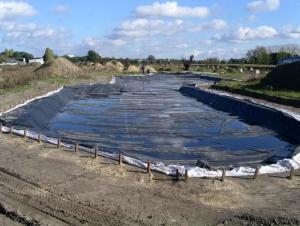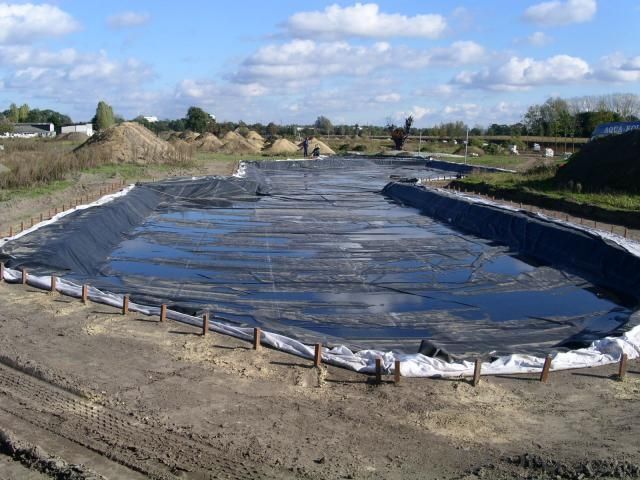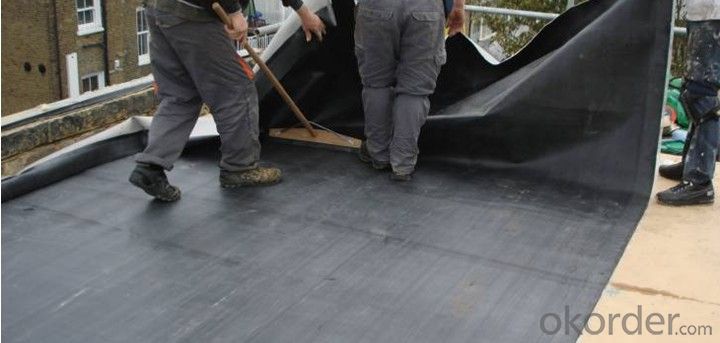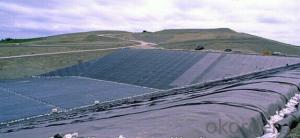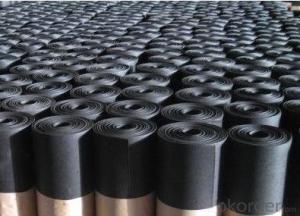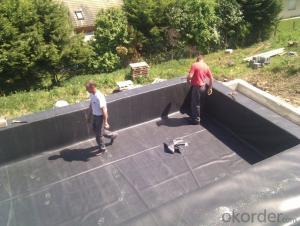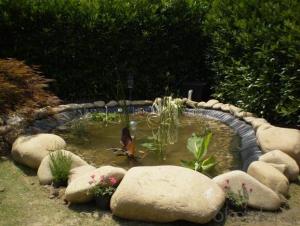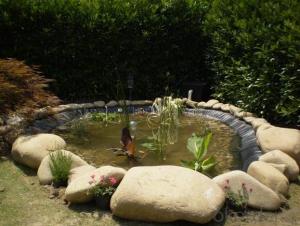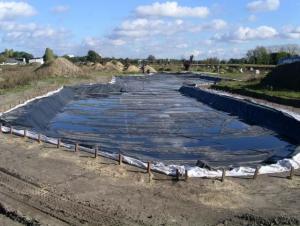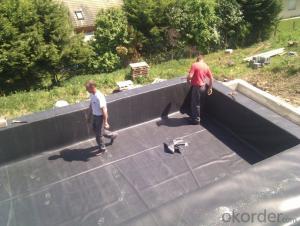EPDM Coiled Rubber Waterproof Membrane for Big Pond
- Loading Port:
- Shanghai
- Payment Terms:
- TT OR LC
- Min Order Qty:
- 50000 m²
- Supply Capability:
- 5000000 m²/month
OKorder Service Pledge
OKorder Financial Service
You Might Also Like
EPDM Coiled Rubber Waterproof Membrane for Big Pond
Description Of EPDM Coiled Rubber Waterproof Membrane for Big Pond:
•EPDM waterproof sheet has excellent anti-ozone-aging performance, able to resist ultraviolet light and corrosion of many chemical corrosive materials in the atmosphere
•It has high tensile strength, high ductility and strong retractility, it has excellent crack resistance, able to effect waterproof function even with tiny vibration of buildings.
• Excellent resistance to ozone, oxidation and sunlight.
• Resistance to chemicals; resistant to most inorganic products.
Main Features of EPDM Coiled Rubber Waterproof Membrane for Big Pond:
A.Polyester based SBS Modified Bitumen Waterproofing Membrane
a. Strong impermeability
b. High tensile strength, elongation, ability to adapt the grassroots shrinkage deformation and cracking
c. Puncture-resistant, broken resistant, tear-resistant
d. The corrosion resistance, resistance to mildew, weathering good
e. Construction convenient, hot-melt can be operated Four Seasons Construction, reliable joints
Specifications of EPDM Coiled Rubber Waterproof Membrane for Big Pond:
| Material | EPDM Rubber |
| Size | 1.2m (width)*20m (length) or customized, weldable type 2.05m or 4m width |
| Thick | 1.2mm, 1.5mm, 2.0mm |
| Type | Vulcanized & Weldable |
| Pattern | Non-reinforced (homogeneous) |
| Certificate | ISO9001/14001 |
Applications of EPDM Coiled Rubber Waterproof Membrane for Big Pond:
1. The substratum should be smooth, dry, clean, which can not have loosing and peeling phenomena.
2. Before application, clean up the basic level and eradicate the impurities.
3. Spread out the membrane on the substratum to loose sheet's stress. Use adhesive-glue to paint the substratum and the surface of membrane. When the adhesive is not sticky to hands, pave and press smoothly.
4. When pave the second volume of membrane, extrude 100mm of the edge of overlap of the first roll and do not paint with the adhesive. Pave the membrane on the substratum according to step so as to finish the whole pavement. When paving, do not tighten the waterproof membrane violently.
5. After that, use the special solvent to scrub the overlap joint. When it becomes fully dry , use the sheet glue to paint the both sides of the joint. Paint it again when it gets completely dry. Till the adhesive is not sticky to hands, press it smoothly and solidly.
6. Pay attention to fire prevention during application. Basement construction site shall be equipped with ventilation facilities



IMages of EPDM Coiled Rubber Waterproof Membrane for Big Pond:




FAQ of EPDM Coiled Rubber Waterproof Membrane for Big Pond:
1. What are we supplying?
We are specialized in producing Colorful Asphalt Roof Shingle, SBS/APP modified bitumen waterproof membrane, Self adhesive bitumen waterproof membrane, PVC waterproofing membrane, EPDM rubber roofing membrane, Single Component Polyurethane Waterproof Coating, and Spray Polyurea Waterproof Coating
.
2. How Many years experience do we have?
We have been exported to more than 20 countries in the past 15 years.
3. How long do we usually reply your request?
We always reply our customer within 24 hours.
- Q: Can a waterproofing membrane be used for exterior foundation walls?
- Yes, a waterproofing membrane can be used for exterior foundation walls. Waterproofing membranes are designed to provide a protective barrier against water infiltration, and they are commonly used in construction to prevent moisture from entering below-grade structures such as foundation walls. These membranes are typically made of durable materials like rubber, asphalt, or polymer-based compounds that are resistant to water penetration. By installing a waterproofing membrane on the exterior side of foundation walls, it creates a barrier that prevents water from seeping into the foundation, which can help to prevent issues such as water damage, mold growth, and structural deterioration. Additionally, waterproofing membranes can also help to reduce the potential for cracks and leaks in the foundation, enhancing the overall durability and longevity of the structure.
- Q: Can a waterproofing membrane be used for concrete tank linings?
- Yes, a waterproofing membrane can be used for concrete tank linings. A waterproofing membrane is designed to create a barrier against water penetration, which makes it suitable for protecting concrete tanks from potential leaks or moisture damage.
- Q: Can a waterproofing membrane be used for hotels or resorts?
- Certainly, hotels or resorts can utilize waterproofing membranes. These membranes are widely employed in the construction sector to safeguard different structures against water damage, which includes hotels and resorts. Their objective is to create a barrier that hinders water infiltration, effectively averting leakages and moisture-related concerns. To ensure lasting protection, these membranes can be expertly applied to various areas within a hotel or resort, such as roofs, basements, bathrooms, swimming pools, and balconies. The implementation of a waterproofing membrane in these establishments is crucial to uphold structural integrity, forestall water damage, and offer guests a comfortable and secure environment.
- Q: How does a waterproofing membrane compare to other waterproofing methods?
- A waterproofing membrane is highly effective in preventing water intrusion compared to other waterproofing methods. It forms a continuous barrier that is resistant to water penetration, protecting the underlying structure from moisture damage. Unlike other methods like sealants or coatings, a membrane offers superior durability and flexibility, ensuring long-term waterproofing performance. Additionally, membranes are easy to install and can cover large areas efficiently, making them a preferred choice in various construction projects.
- Q: Can a waterproofing membrane be installed on a sloping surface?
- Yes, a waterproofing membrane can be installed on a sloping surface. In fact, it is often necessary to install a waterproofing membrane on sloping surfaces to ensure proper water drainage and prevent water seepage.
- Q: Are waterproofing membranes resistant to mold and mildew?
- Yes, waterproofing membranes are resistant to mold and mildew. They create a barrier that prevents moisture from seeping through, which helps inhibit the growth of mold and mildew.
- Q: Can waterproofing membranes be used on balconies?
- Indeed, balconies can benefit from the utilization of waterproofing membranes. Specifically engineered to establish a safeguarding shield against water infiltration, these membranes prove to be an optimal remedy for balconies that are susceptible to weather conditions like rain, snow, and moisture. Generally, these membranes are administered onto the balcony's surface, creating a continuous and impermeable seal that effectively obstructs the passage of water, thus averting harm to the underlying structure. By employing waterproofing membranes on balconies, one can effectively prolong their lifespan, diminish maintenance expenses, and guarantee their general resilience and functionality.
- Q: Can a waterproofing membrane be exposed to extreme temperatures?
- Yes, a waterproofing membrane can generally be exposed to extreme temperatures. Most waterproofing membranes are designed to withstand a wide range of temperatures, including both high and low extremes. However, it is important to note that the specific temperature limits and performance characteristics may vary depending on the type and brand of the membrane. It is always recommended to consult the manufacturer's specifications and guidelines to ensure the membrane is suitable for the specific temperature conditions it will be exposed to. Additionally, it is important to consider other factors such as UV exposure and thermal expansion/contraction that may affect the overall performance and longevity of the waterproofing membrane in extreme temperature conditions.
- Q: Can a waterproofing membrane be used in conjunction with green building practices?
- Certainly, a waterproofing membrane can be utilized alongside green building practices. In actuality, integrating a waterproofing membrane into the construction of a green building can greatly enhance its overall sustainability and efficiency. One of the fundamental principles of green building practices is to maximize energy efficiency and decrease the environmental impact of a structure. By installing a waterproofing membrane, the building's outer covering can be shielded from moisture intrusion, thereby preventing water damage and potential mold growth. This, in turn, aids in preserving the structural integrity of the building, reducing the necessity for costly repairs and replacements, which can consume resources and generate waste. Moreover, a waterproofing membrane can contribute to improved indoor air quality. By preventing water infiltration, it assists in creating a dry and healthy living or working environment, minimizing the risk of respiratory problems and other health issues associated with dampness. Furthermore, a waterproofing membrane can enhance the energy efficiency of a building. By preventing water from seeping into the walls or foundation, it lessens the potential for heat loss through moisture evaporation, thus reducing the energy required for heating and cooling. This can lead to decreased energy consumption and lower carbon emissions, aligning with the objectives of green building practices. However, it is crucial to select a waterproofing membrane that is environmentally friendly and compliant with green building standards. Seek out membranes that are crafted from recycled or sustainable materials and possess low VOC (volatile organic compound) content. Additionally, consider opting for a membrane that is designed for longevity and durability, as this can further minimize the environmental impact by reducing the need for replacement over time. In conclusion, a waterproofing membrane can be an invaluable addition to any green building endeavor. It serves to safeguard the building envelope, enhance indoor air quality, and improve energy efficiency. By choosing an environmentally friendly membrane, the overall sustainability of the building can be further enhanced.
- Q: Can a waterproofing membrane be used for tunnels or underground structures?
- Yes, a waterproofing membrane can be used for tunnels or underground structures. Waterproofing membranes are specifically designed to prevent the ingress of water and protect structures from moisture damage. Tunnels and underground structures are often exposed to groundwater or high levels of moisture, making waterproofing essential to maintain their integrity and durability. The waterproofing membrane is applied to the exterior surface of the tunnel or underground structure, creating a barrier that prevents water penetration. It acts as a protective layer, preventing water from seeping through the walls, roof, or floor. There are various types of waterproofing membranes available, including bituminous, polyurethane, and cementitious membranes. Each type offers different properties and advantages depending on the specific requirements of the project. In addition to preventing water infiltration, waterproofing membranes also provide protection against other potential issues such as corrosion, mold growth, and structural damage. They help to extend the lifespan of the tunnel or underground structure and reduce maintenance and repair costs. It is important to ensure that the waterproofing membrane is properly installed by qualified professionals to ensure its effectiveness. Regular inspections and maintenance are also crucial to identify any potential issues and address them promptly. Overall, a waterproofing membrane is a highly effective solution for tunnels and underground structures, providing long-lasting protection against water damage and ensuring their structural integrity.
Send your message to us
EPDM Coiled Rubber Waterproof Membrane for Big Pond
- Loading Port:
- Shanghai
- Payment Terms:
- TT OR LC
- Min Order Qty:
- 50000 m²
- Supply Capability:
- 5000000 m²/month
OKorder Service Pledge
OKorder Financial Service
Similar products
Hot products
Hot Searches
Related keywords
